Only 14% of businesses still prefer large national or international banks to alternative lenders.
Note: This article is intended to inform our readers about business-related concerns in the United States. It is in no way intended to provide financial advice or to endorse a specific course of action. For advice on your specific situation, consult your accountant or financial consultant.
Compared to their larger competitors, small and midsize businesses (SMBs) face a variety of obstacles when it comes to securing traditional financing—such as a line of credit or a loan—from large or international banks. Especially in an economy where inflation is the highest it’s ever been in decades and a recession looms large.
If this environment wasn’t challenging enough, recent closures of big-name lenders such as Silicon Valley Bank (SBV), Signature Bank, and First Republic Bank see many similar institutions facing the risk of failure. Securing financing from similar entities is more difficult than ever for SMBs.
Have these economic factors and disruptions in the banking system changed how SMBs will approach external funding? Capterra’s 2023 Financing Survey* of 458 SMB leaders found that only 39% of businesses feel completely confident turning to large or international banks for financing in the future, and 43% of organizations say the recent banking closures will fundamentally change how they approach traditional financing in the future. With their viewpoint on traditional lenders shifting, many SMBs are exploring how alternative financiers can meet their needs.
Whether it be through traditional trails or alternative avenues, SMBs have a variety of means to obtain funding. If your business is tentative about going to a large or international bank, there are other solutions available. By exploring the top reasons SMBs are denied financing, what forms of funding they gravitate toward, and more, this report can help your business navigate the financing process through these trying economic times.
/ Key findings
56% of businesses have been denied financing more than once in the last two years due to lack of collateral, poor cash flow, or high (or too low) credit utilization.
More than 50% of SMBs often go to large or international banks for financing.
SMBs say the most attractive alternatives to large or international banks are small regional banks, merchant cash advance providers, and Community Development Financial Institutions (CDFI) or other community lenders.
23% of businesses say the FDIC’s account insurance coverage isn’t enough, and a majority of businesses say that more regulation (64%) and more enforcement (59%) of the banking industry is needed.
A majority of SMBs (78%) partner with third-party services to help them apply for loans or to obtain funding.
SMBs call for more government oversight of the industry as they pull funds from banks
In March, the Federal Deposit Insurance Corporation (FDIC) took control of Silicon Valley Bank after the company’s investments greatly decreased in value and depositors incurred a bank run, believing the bank was set to fail. On the heels of its closure, Signature Bank was shut down by regulators in an attempt to assuage panic, as they feared financial contagion would spread to the rest of the banking sector.
These closures have been the biggest bank failures since Washington Mutual went defunct in 2008 and have raised fears about the health of the banking industry[1]. Although bank failures aren’t new—more than 550 banks have shut down from 2001 to 2023—this has impacted SMBs' view of the industry[2].
Given the news, 43% of businesses report that this will fundamentally change how they approach traditional financing in the future, which includes which types of loans they will pursue and which partners they will work with. Though 77% of businesses feel that current assurances like the FDIC’s account coverage of up to $250,000 per account are enough, 64% have decided to withdraw some or all of their funds from their primary banking institution.
This attitude shift has also changed their perspective on government regulation and enforcement of the banking industry:
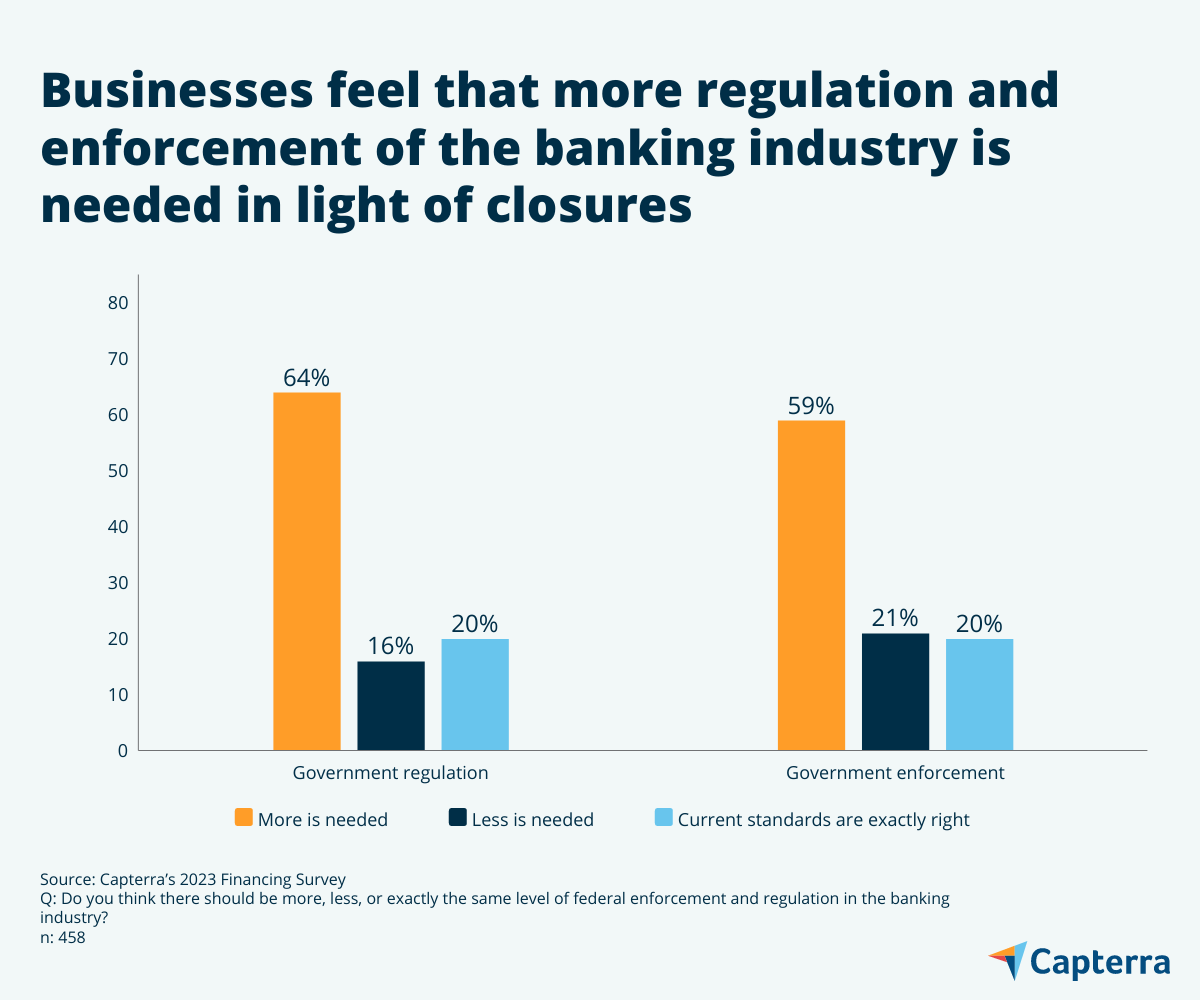
/ Our recommendation
Regardless of whether your bank is large or international, online, small, or regional/local, you should always ensure that your money is at an FDIC-insured bank. You can confirm this by visiting the FDIC’s BankFind Suite[3]. Additionally, it might be prudent to spread your cash reserves across multiple accounts to ensure your savings are covered in full.
Big bank alternatives are attractive to SMBs as financiers of the future
All of the businesses we surveyed say that they are currently seeking financing right now or plan to in the future. As an alternative to large/international banks, SMBs are looking to small or regional/local banks, CDFIs or other community lenders, and merchant cash advance providers as financing partners. While the source of financing has changed, SMBs still prefer traditional funding options, such as opening up lines of credit or credit cards, taking out personal or SBA loans, and applying for grants.
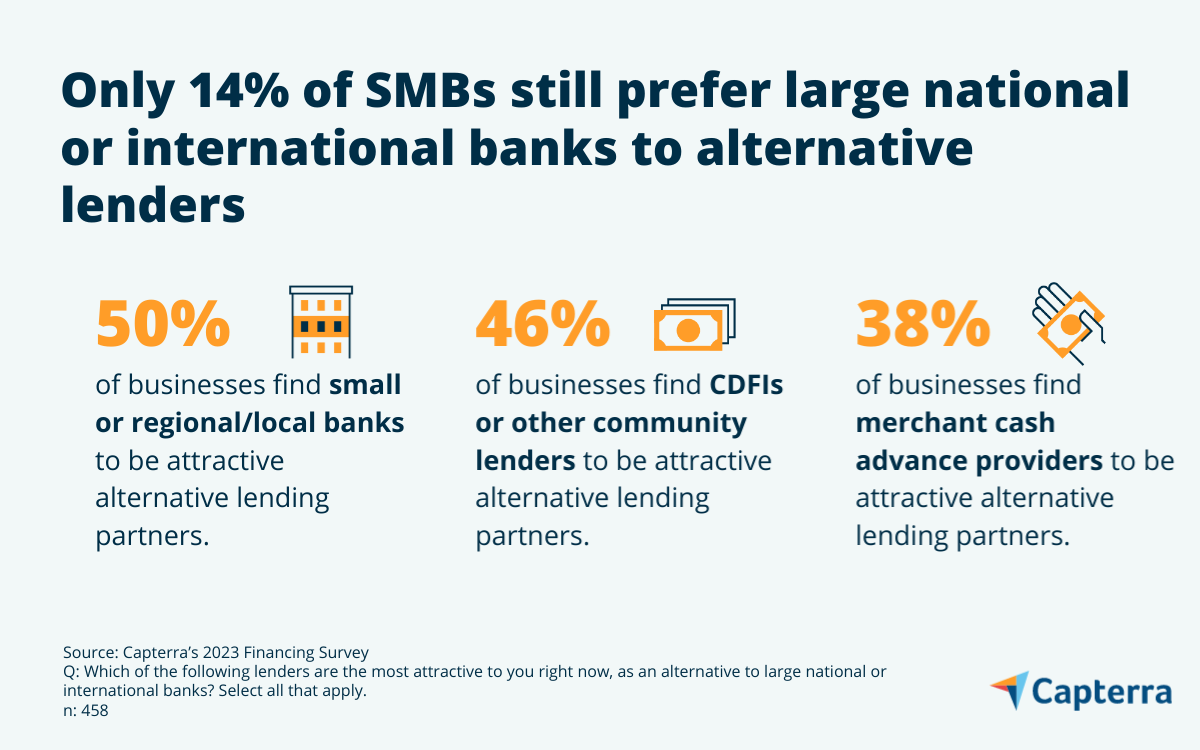
Typically, large or international banks can provide SMBs with larger loans than alternative lenders. For instance, the average SMB loan sought from big banks sits around $600,000. In comparison, alternative financiers, such as online lenders, average out between $25,000 to $100,000[4].
Overall, only 20% of businesses report seeking financing in the realm of what the average alternative lender can provide, as a majority are looking for more than $100,000 in funding.
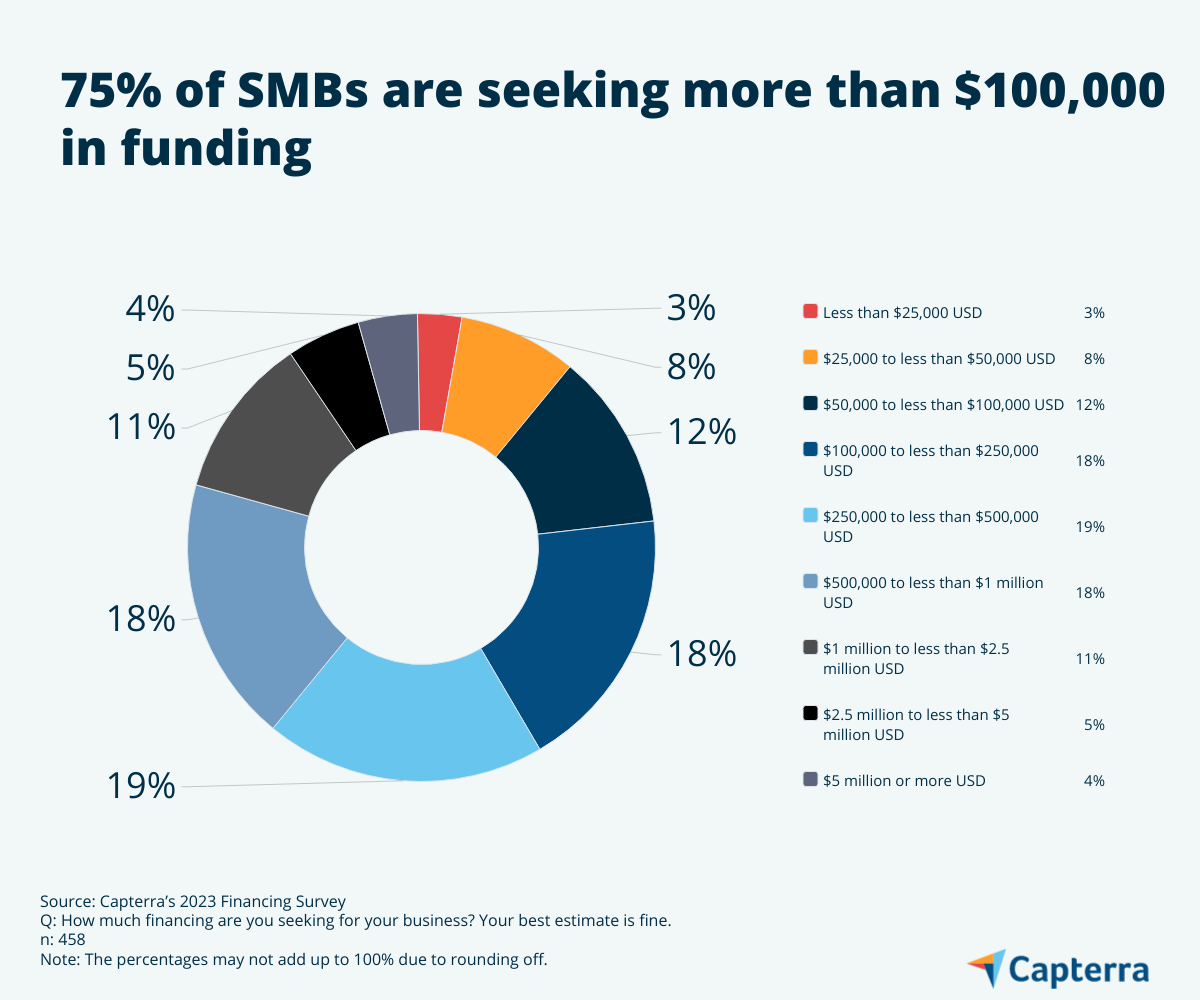
The leading areas organizations say they would devote funding to include working capital (49%), equipment (38%), or inventory (35%).
Compared to large or international banks, alternative financiers generally have more flexible lending requirements, which can help SMBs access funding more quickly to capitalize on an opportunity or a demand surge. For instance, if investing in equipment or inventory is critical, a CDFI can offer a loan with longer repayment terms and at more affordable interest rates so that SMBs can avoid undue financial strain on operations.
Although a vast majority of businesses (83%) say they are currently operating on the financing they’ve obtained within the past two years, 63% report that they feel this financing will last anywhere from three months to less than a year. With this in mind, SMBs should carefully consider how much money they need, how quickly they need funding, and their business qualifications to ensure business survival and prosperity. Based on their circumstances, alternative lenders can sometimes prove to be better partners than large or international banks, especially when expedient funding is needed.
/ Our recommendation
Nonprofits such as the Service Corps of Retired Executives (SCORE) provide free templates and other resources that can help businesses apply for a loan or to determine if an alternative option like an online lender is right for their organization[5]. Additionally, a certified financial planner (CFP) or an accounting firm can assist you with creating a financial plan that has the appropriate funding estimate for your business needs. These professionals can also help you find the right alternative lender.
SMBs face challenges with funding, but new government lending programs can ease the process for some
Large or international banks scrutinize a company’s credit score and their financial statements, and sometimes conduct market and industry analysis to ascertain if applicants are creditworthy. This makes attaining traditional financing especially difficult for SMBs. Our survey respondents say the leading challenges they face when seeking funding include grappling with high-interest rates (50%) and navigating a lengthy and complicated application process (38%), among other hurdles like working in a risky industry or already carrying too much debt.
SMBs report that they are turned down because of a lack of collateral, a credit utilization ratio that is too high or low, and poor cash flow, and unfortunately, within the last two years, 56% of businesses have been denied financing at least once.
While our survey didn’t find any significant difference in denial rates between male (64%) and female applicants (55%), there are other hurdles to traditional financing that women and minorities have historically struggled with—such as finding business development resources, dealing with a lack of business self-confidence, and navigating market saturation, for example[6].
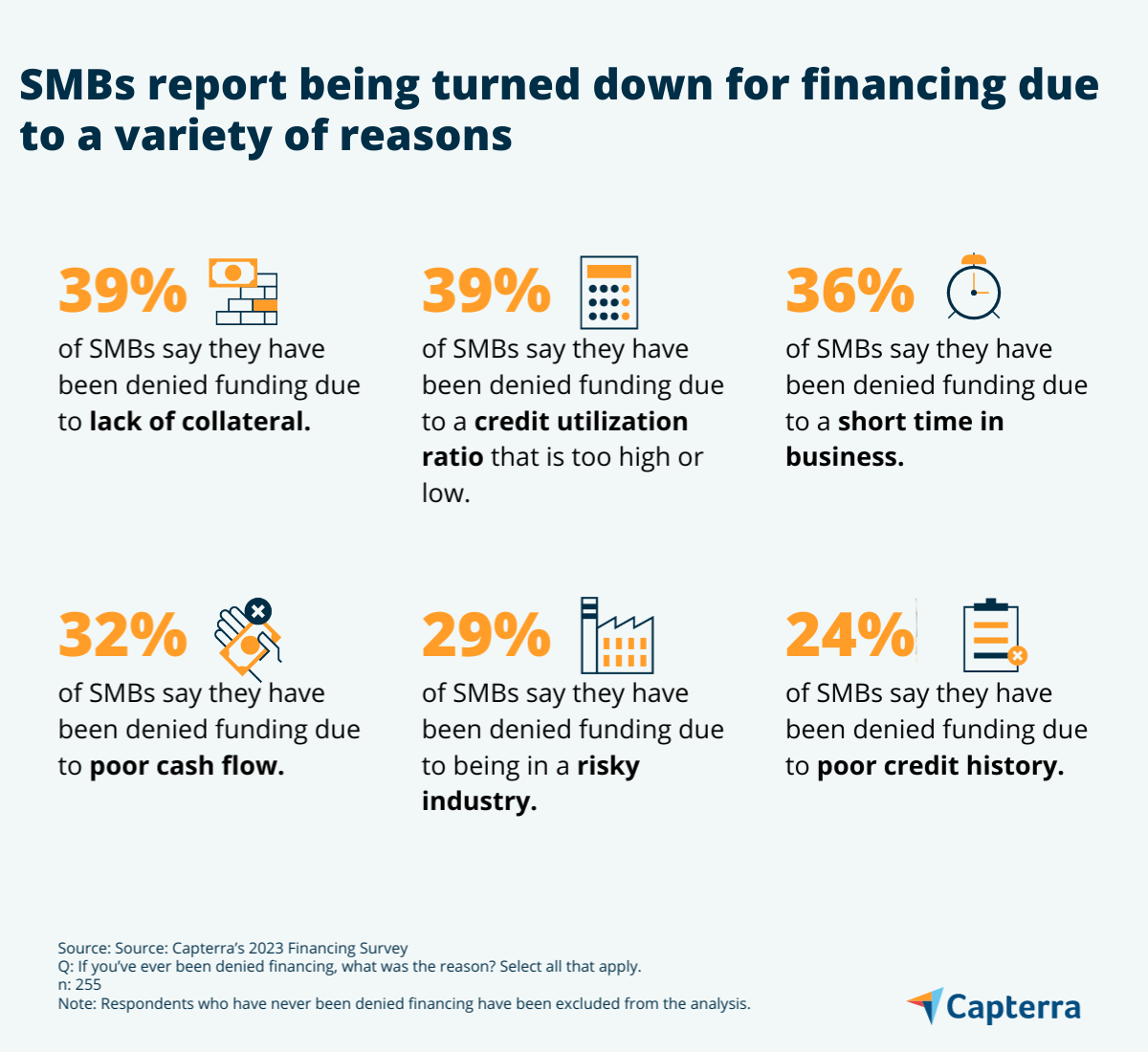
With that said, as opposed to working with a large or international bank for funding, SMBs, and especially those helmed by underserved communities, which include women, minorities, veterans, and rural entrepreneurs, can take advantage of freshly modernized and expanded Small Business Administration (SBA) lending programs[7].
Through initiatives like the SBA's Community Advantage loan program, organizations can now tap an expanded list of lenders—which include Certified Development Companies (CDCs), non-federally regulated CDFIs, and more—to access government-backed, SBA-guaranteed loans, lines of credit, interest-only periods, and other loan modifications catered to the needs of SMBs.
/ Our recommendation
SBA loan programs all come with unique requirements based on the lender and type of financing. Though you can work with a large or international bank to acquire an SBA loan, alternative lenders offer greater requirement flexibility, more personalized services, faster loan processing times, and more. Finding the right alternative SBA-lender for your business can sometimes get tricky—thankfully, the SBA’s LenderMatch tool can help[8].
Software strengthens SMBs’ ability to secure financing
Applying for and obtaining any form of financing, whether that’s from a traditional lender like a large or international bank or through an alternative partner like a CDFI, can get complicated quickly. More than three-fourths (78%) of businesses partner with a third-party service, like an accounting firm, to help them apply for loans or to obtain funding; however, many businesses also look to technology to assist in this process.
Only a sliver of SMBs (4%) say that they have not used software to assist with business financing in the past and don’t plan to in the future.
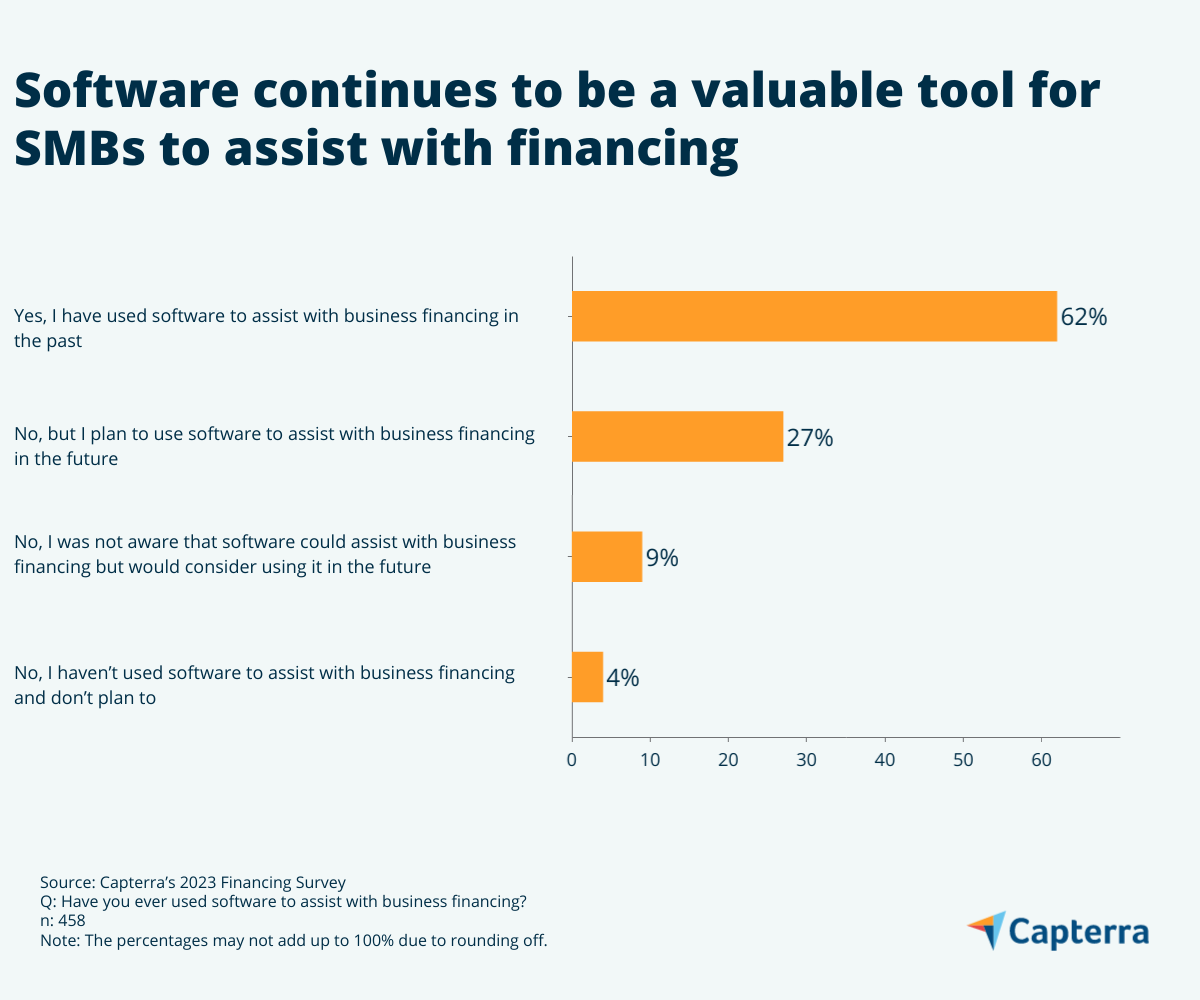
Much of the technology respondents already report using, such as budgeting and forecasting software (37%) or cash flow management software (48%), can provide businesses with the ability to track their expenses or create financial projections and scenarios, which provide important indicators lenders use to determine if a business is creditworthy.
Notably, only 32% of businesses make use of loan origination software, which can be used by SMBs to apply for financing directly from certain lenders. From document to compliance management and more, this technology can help SMBs save money and time by streamlining the process via automation. With that said, not all loan origination software is designed for these purposes, so SMBs curious about leveraging its capabilities should research solutions and know that, regardless of what software is being used, lenders may have specific criteria for applicants.
/ Our recommendation
Though piecemeal solutions like loan origination or budgeting and forecasting software can assist with navigating obtaining financing, general accounting software often bundles the capabilities of these technologies with other tools that can enable businesses to approach the process more holistically.
Fielding financing can be complex, but it doesn’t have to be
External funding is the lifeblood of businesses and there are a myriad of options and lenders SMBs can work with to secure the financing they need. Given the recent volatile banking climate, you might be interested in partnering with alternative lenders to large or international banks to navigate this process, and finance professionals such as a CFP or accounting firm can help you explore the perfect fit for your business needs. Software can also assist you with identifying key metrics and creating financial reports that can increase your chance of success when applying for funding.
Whatever solution works for you, here are some additional tips so that you can approach traditional financing with confidence moving forward:
Have a strong business plan: Make sure your company’s financial plan is well-written, comprehensive, and realistic, as lenders will want to see a detailed plan that details your organization’s goals, strategies, and financial projections.
Maintain a good credit score: Though some financing options and lenders weigh credit scores more lightly, securing traditional funding hinges upon this metric. Pay your bills on time, keep your credit utilization rate low, and if needed, correct any errors on your credit report.
Build relationships with lenders: Attending network events, joining industry associations, and seeking referrals from other SMB leaders can connect you with potential financiers, which can improve your chances of securing funding.
The resources don’t stop there. Check out some of the top trends that will shape the financial field in the coming years, and familiarize yourself with expert advice on some key budgeting best practices so that you can confidently may the most of any funding you receive.

